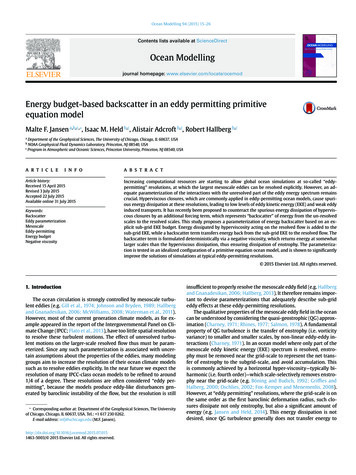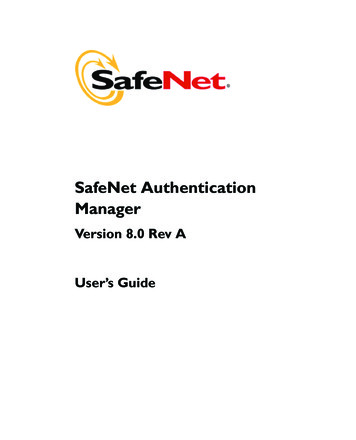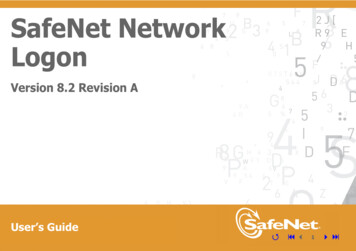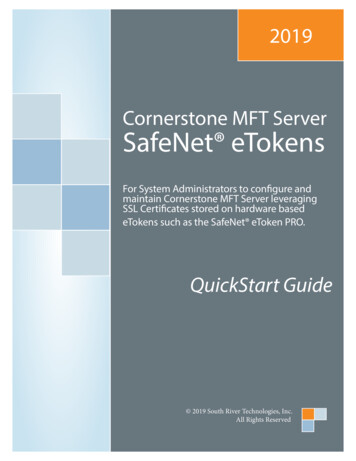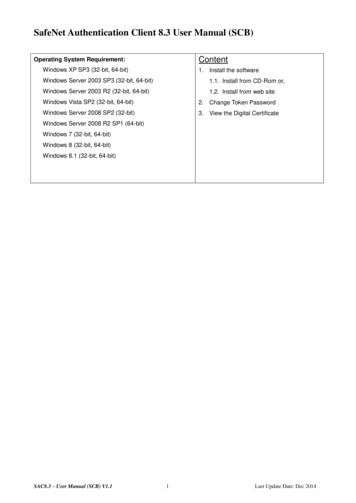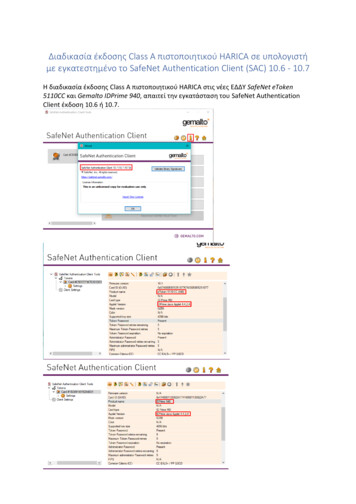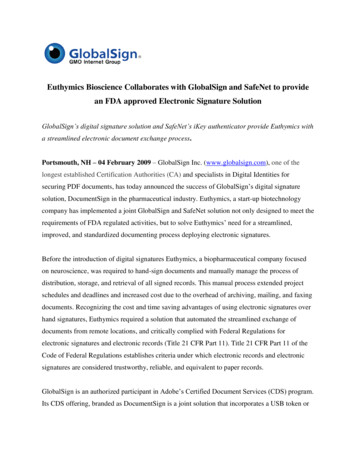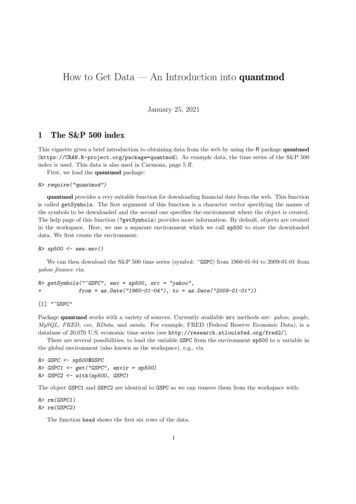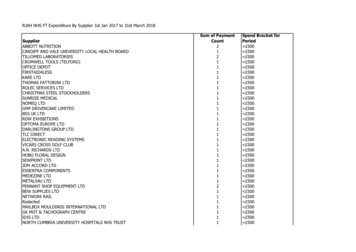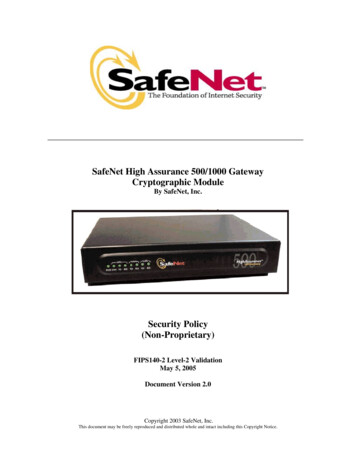
Transcription
SafeNet High Assurance 500/1000 GatewayCryptographic ModuleBy SafeNet, Inc.Security Policy(Non-Proprietary)FIPS140-2 Level-2 ValidationMay 5, 2005Document Version 2.0Copyright 2003 SafeNet, Inc.This document may be freely reproduced and distributed whole and intact including this Copyright Notice.
Table of FERENCES .3TERMINOLOGY .3VERSION HISTORY .3ACRONYMS AND ABBREVIATIONS .3HIGHASSURANCE 500/1000 GATEWAY .62.1SECURE REMOTE MANAGEMENT SOFTWARE .73SECURITY LEVELS .74CRYPTOGRAPHIC MODULE 4.5.54.64.6.14.74.7.14.7.2OPERATIONAL ENVIRONMENT.9MODULE INTERFACES .9SUPPLY VOLTAGE AND CURRENT .10EMI/EMC.11ROLES AND SERVICES .11Roles .11Crypto Officer Authentication.11Crypto Officer Services.12User Authentication and Services .12Separation of Roles and Services.13CRYPTOGRAPHIC ALGORITHMS, SECURITY FUNCTIONS AND KEY MANAGEMENT .13Other Security Functions .15SELF-TESTS .15Power-Up Self-Test.15Conditional Tests .165FIPS 140-2 MODE .166FIPS 140-2 LEVEL 2 NON-COMPLIANT MODE .177SECURITY 7.57.67.77.7.17.7.27.7.37.7.47.8IDENTIFICATION & AUTHENTICATION SECURITY RULES .17Cryptographic Officer Identification and Authentication.17User Identification and Authentication.18REAUTHENTICATION AFTER A POWER CYCLE .18STRENGTH OF AUTHENTICATION.18Crypto Officer Password Strength.19Pre-Shared Key Strength .19IKE Pre-Shared Key Strength.19RSA Authentication Strength.19SOFTWARE AND FIRMWARE LOADING SECURITY RULES .20ACCESS CONTROL SECURITY RULES .20PHYSICAL SECURITY POLICY .20KEY MANAGEMENT SECURITY POLICY .21Cryptographic Key Generation.21Cryptographic Key Entry/Output.21Cryptographic Key Storage .21Cryptographic Key Destruction.21MITIGATION OF OTHER ATTACKS SECURITY POLICY .22APPENDIX A — HA500/1000 SERVICES.222
1Introduction1.1 PurposeThis is a non-Proprietary FIPS 140-2 Security Policy for the SafeNet HA500/1000 Gatewayproducts. The Security Policy describes how the HA500/1000 meets all FIPS 140-2 Level 2requirements, and was prepared as part of the HA500/1000’s FIPS 140-2 certificationsubmission package.FIPS 140-2 (Federal Information Processing Standards Publication 140-2) is a U.S. Governmentstandard entitled “Security Requirements for Cryptographic Modules.” This standard mandates aset of strict design and documentation requirements that hardware and software cryptographicmodules must meet in order to be certified by the U.S. National Institute of Standards andTechnology (NIST) and the Canadian Communications Security Establishment (CSE).This document is intended for use by FIPS 140-2 testers, NIST and CSE reviewers, and othersinterested in how the HA500/1000 meets all FIPS 140-2 Level 2 requirements.1.2 ReferencesThis FIPS 140-2 Security Policy describes features and designs of the HA500/1000 using thetechnical terms of FIPS 140-2. For more information on the FIPS 140-2 standard and validation program readers arereferred to the NIST web site at http://csrc.nist.gov/cryptval/. For more information on the HA500/1000 product, please visit the SafeNet web site athttp://www.safenet-inc.com.1.3 TerminologyIn this document the SafeNet HA500/1000 is referred to as the module, the HA500/1000 device,the device, and the HA500/1000.1.4 Version HistoryVersion /030.0910/21/03CommentsInitial draftSecond draftSubmission draftInc SafeNet CommentsInc COACT comments on v0.04Inc Coact/SafeNet comments on v0.05Inc Coact comments on v0.06FinalizedUpdates as per initial consistency review1.5 Acronyms and AbbreviationsANSIAmerican National Standards InstituteAPIApplication Programming InterfaceCACertificate Authority3NameWard RosenberryWard RosenberryWard RosenberryWard RosenberryWard RosenberryWard RosenberryWard RosenberryAdam BellAdam Bell
CCCBCCLICMVPCSECSPDESDSAEDCEMCEMIFCCFIPSFIPS RDISSHSSLTFTPTLSVPNWLANConfiguration CertificateCipher Block ChainingCommand Line InterfaceCryptographic Module Validation ProgramCommunications Security EstablishmentCritical Security ParameterData Encryption StandardDigital Signature AlgorithmError Detection CodeElectromagnetic CompatibilityElectromagnetic InterferenceFederal Communication CommissionFederal Information Processing StandardData Encryption Standard (DES)Graphical User InterfaceHigh Assurance 500 GatewayHigh Assurance 1000 GatewayKeyed-Hash Message Authentication CodeInstitute of Electrical and Electronics EngineersInternet ProtocolInternet Protocol SecurityKnown Answer TestLocal Area NetworkLightweight Directory Access ProtocolLight Emitting DiodeMessage Authentication CodeMessage Digest version 5Network CertificateNetwork Interface CardNational Institute of Standards and TechnologyNational Voluntary Laboratory Accreditation ProgramPseudo Random Number GeneratorPublicationRandom Access MemoryRead Only MemoryRandom Number GeneratorRivest Shamir and Adleman AlgorithmSecurity AssociationSecure Hash AlgorithmSecurity Management ConsoleSimple Network Management Protocol version 2Security Related Data ItemSecure ShellSecure Sockets LayerTrivial File Transfer ProtocolTransport Layer SecurityVirtual Private NetworkWireless Local Area Network4
5
2HighAssurance 500/1000 GatewayThe SafeNet HA500/1000 Gateway is a high-performance, standards-based hardware VirtualPrivate Network (VPN) and firewall. Providing a high speed, low cost solution, it features thestrongest cryptography available and complete manageability. SafeNet custom designed a stateof-the-art Application Specific Integrated Circuits (ASIC) for the HA500/1000 that allowsencryption using either AES, DES (legacy systems only), or triple-DES as needed by clientapplications.The HA500 Gateway and HA1000 Gateway are identical in circuitry and software. They differonly in product name (and labeling) and by a factory set configuration parameter that defines thenumber of VPN tunnels that can be established at a given time.The HA500/1000 supports the internationally standardized Internet Protocol Security (IPSec)protocol and Internet Key Exchange (IKE) protocol. Whether securing an enterprise perimeter, acorporate sub-network, or a single host, the HA500/1000 controls network access and givesadministrators a complete toolbox of functionality. The HA500/1000 includes the followingfeatures: IPSEC support including IKE (using all modes – main, aggressive, and quick)X.509 v3 Digital Certificates, Public Key Infrastructure Certificate ManagementProtocol (PKIX CMP), and pre-shared keysStrong cryptography using AES, Triple-DES, SHA-1, RSA and DSA (DigitalSignature Algorithm) signing. DES is included for legacy system support only.Tamper-response/evident case.Encryption to enforce policy and provide data privacyCentralized, remote management using SNMPv2 and Telnet (remote managementprotected by a VPN tunnel).Local Management using an RS-232 CLI terminal interface.Secure automated software upgrades and security policy updatesThe HA500/1000 acts as a perimeter guard. The module allows you to create enterprise-wideVirtual Private Networks and to securely link distributed networks by adding a single device infront of the network.A VPNG devicein New YorkInternetTunnel500HA500/1000A VPNG devicein London500HA500/1000IP HostsIP HostsFigure 1 – HA500/1000 Securely Links Remote Networks6
The possible authentication interactions are:1.2.3.4.HA500/1000 to HA500/1000SMC to HA500/1000Other gateways (SafeNet and non-SafeNet) to HA500/1000Software client (SafeNet and non-SafeNet) to HA500/10002.1 Secure Remote Management SoftwareThe Security Management Console (SMC) is powerful remote management software that can beinstalled on an, Windows 2000, Windows XP, or Solaris 8.00 workstation. This softwareprovides a simple, easy-to-use graphical interface to the configurations of the HA500/1000. Italso allows for extensive monitoring of the HA500/1000, allowing an Administrator to remotelykeep track of the module’s status. All communications between SMC and the HA500/1000 arethrough network ports over secure, authenticated IPSEC tunnels. The SNMPv2 protocol andTelnet protocol are used to carry out the management services.3Security LevelsThe HA500/1000 has been evaluated as meeting all FIPS 140-2 requirements at level 2 or highersecurity. Individual security requirements meet the levels indicated in Table 1.Security Requirements SectionCryptographic ModuleCryptographic Module Ports and InterfacesRoles, Services, and AuthenticationFinite State ModelPhysical SecurityOperational EnvironmentCryptographic Key ManagementEMI/EMCSelf TestsDesign AssuranceMitigation of other attacksLevel22223N/A23222Table 1. Security Levels4Cryptographic Module SpecificationIn FIPS terms, the HA500/1000 Gateway is a multi-chip standalone module. The HA500/1000features strong physical security including tamper response circuitry, a tamper-evident case,extruded sheet metal construction, and a SafeNet iridescent sticker. The entire module isencapsulated by the steel case that forms the cryptographic boundary, and only specified physicalinterfaces provide access to the module.The HA500/1000 Gateway consists of the following parts: Hardware Assembly Part Number SE-HA500-01; (for HA1000) SE-HA1000-01.SafeXcel 1141/1741 encryption chip.7
System firmware includes the operating system, boot code and runtime firmware installed inROM (flash memory) as part of the manufacturing process. Firmware consists of: Boot Code Version 07.01 SafeNet OS Version 07.01A crypto officer (an administrator configuring or using the cryptographic module) can examinethe product label to confirm the hardware assembly version number. The versions of firmwarecan be obtained by using the Show Version command which is available to crypto officers(administrators) of the cryptographic module. Figure 2 shows a hardware block diagram of thecryptographic module and indicates the cryptographic boundary.Figure 2 – HA500/1000 Block Diagram and Cryptographic BoundaryCryptographic BoundarySDRAM32 MSDRAMController32bit 50MHzIDT79RC32333Local BusControllerFLASH8MPWRRC32333100 MHzConsoleInterfaceVPN - EDS33 MHz 32-bit PCI BusSafeNet 1141Crypto nnectorThe module uses standard, production-quality components, designed to meet commercial-gradespecifications for power, temperature, reliability, shock and vibration.The HA500/1000 has tamper-evident security tape on the two screws securing the chassishousing that must be removed to access any internal cryptographic module components. Amicroswitch attached to the chassis senses any attempt to open the module. While theHA500/1000 is turned on, if an attempt to remove the module cover is detected the systemresponds by zeroizing any keys or Critical Security Parameters (CSPs) in flash memory (ROM)and disabling data traffic. While powered off, if the chassis cover is even partially removed, themodule will detect the tamper upon the next boot cycle and will not support any cryptographicprocesses. Tamper evidence for the HA500/1000 includes dents and scratches in the metalliccase, damage to the security tape, and severe deformation of any panels.System timing controls and standard memory management design techniques prevent alloperators and executing processes from modifying executing cryptographic processes such asloaded and executing cryptographic program images. Timing controls and operating systemaccess controls prevent operators and executing processes from reading cryptographic softwarestored within the cryptographic boundary. The SafeNet Operating System event log recordsrecord modifications, accesses, deletions, and additions of cryptographic data and CSPs.8
Figure 3 – The Steel-Cased HA500/1000 Features Tamper Response Circuitry4.1 Operational EnvironmentThe cryptographic module has a limited non-modifiable operational environment consisting ofthe SafeNet OS. The physical embodiment is a multichip standalone module.4.2 Module InterfacesTable 2 shows the mapping of the FIPS140-2 logical interfaces to the module’s physicalinterfaces.FIPS 140-2 Logical InterfacesData Input InterfaceData Output InterfaceControl Input InterfaceStatus Output InterfacePower InterfacePhysical InterfacesPrivate/Public Ethernet portsPrivate/Public Ethernet portsPrivate/Public Ethernet ports, Serialport, reset switch DC powerconnectorPrivate/Public Ethernet ports, Serialport, Front Panel LEDsDC power connectorTable 2. Logical to Physical Interface Mappings.The HA500/1000 has status indicators on the front panel that allow quick and easy assessment ofthe working condition of the module. These indicators show traffic through the module and if thepower is connected. Policy indicators show when user traffic is passing in the clear, blocked oris being encrypted. Figure 4 and 5 depict the front/rear panel of the module. There is also astandard serial port for local configuration.9
Figure 4 – Indicators Show The Status Of The DeviceThe HA500/1000 provides 10/100BaseT Ethernet Ports that allow it to plug directly into anexisting network.Figure 5 – Standard Interfaces Plug Directly Into Your NetworkAs shown in Figure 5 above, the private and public Ethernet ports (10/100baseT) are on the rearpanel of the HA500/1000. There is also a standard RS232 serial console port for localconfiguration. Local management and monitoring services are available through the console port.However, using the secure SMC management station, an administrator can conveniently andremotely access and modify all configurations of the HA500/1000 through the Ethernet ports.Secured IPSec connections allow administrators to securely monitor and administer theHA500/1000 from remote locations.The reset button provides three separate functions: Pressing the reset button for 5 seconds resets the speed of the console to 9600 bps andrestores the private IP address to 10.10.10.1 Pressing the reset button for 30 seconds triggers the following sequence of events: Startup.cfg (containing current configuration settings) is erased from the file system Manufacturing.cfg (containing default configuration settings) is copied to startup.cfg The unit reboots.Holding down the reset button while the unit is booting causes the module to ignore thestartup.cfg file on booting and to use the manufacturing configuration for this boot session.The next boot uses the normal startup configurationTo reboot the module using the current configuration, cycle the power.4.3 Supply Voltage and CurrentThe HA500/1000 draws 12 VDC at 800 mA. Figure 6 shows the power connector10
Not Used12 VDC @ 800 mAFigure 6 – Power Connector Pin Descriptions4.4 EMI/EMCThe module meets FCC requirements in 47 CFR Part 15 for personal computers and peripheralsdesignated for home use (Class B), and is labeled in accordance with FCC requirements.4.5 Roles and ServicesThe HA500/1000 uses role-based authentication to provide access to cryptographic moduleservices.4.5.1RolesThe HA500/1000 employs role-based authentication of its operators and supports two roles:crypto officer and user.The crypto officer role is responsible for the configuration and management of the HA500/1000.The local crypto officer interfaces with the HA500/1000 through the local console port using thecommand line interface (CLI) or by using telnet (and the CLI) through the private Ethernet port.A remote crypto officer interfaces with the HA500/1000 through an IPSec-secured publicEthernet port using the SafeNet Management Console (SMC).The local crypto officer has three capabilities in addition to those provided to remote cryptoofficers. These additional local crypto officer capabilities include: Initial configuration and secure setup of the HA500/1000.Enabling and disabling remote crypto officer access. Remote crypto officer access is initiallydisabled.Use of the ENG password to perform low-level functions on the HA500/1000. Low-levelfunctions that alter the cryptographic module configuration violate FIPS compliance. TheENG (engineering) password is for emergency use only. It is not delivered with the modulebut can be obtained only by contacting SafeNet.Note that local crypto officers do not use secure IPSEC sessions to communicate with thecryptographic module so they do not generate, use, or destroy cryptographic keys consisting ofDiffie-Hellman keys, RSA asymmetric keys, or AES, TDES, or DES symmetric keys.4.5.2Crypto Officer AuthenticationA local crypto officer authenticates using the crypto officer password. A default crypto officerpassword is available for initially configuring the HA500/1000. In FIPS mode, this passwordmust be changed when initialization completes.11
A remote crypto officer (using the SMC software) initially authenticates to the module using thepre-shared key and then using the crypto officer password. Once authenticated, the remote cryptoofficer generates an RSA public/private keypair and exports the public key as a PKCS#10certificate request. A CA issues a public key certificate which is then loaded into the module. Allsubsequent management sessions use RSA signatures for authentication within the IKE protocolas well as the crypto officer password before cryptographic module services are offered to theremote crypto officer.4.5.3Crypto Officer ServicesExcept for the three cryptographic module services provided only to local crypto officers(described in Section 4.5.1), the cryptographic module offers the following cryptographicservices to remote crypto officers: RSA key generationRSA signature generationDiffie Hellman key generationDiffie Hellman key agreementDES, TDES, AES encryption and decryption (DES allowed for legacy support only)The above cryptographic services are provided as part of IPSEC and IKE protocols.Other services available to crypto officers include: Self-testShow StatusHashingMACingKey ZeroizationThe HA500/1000 Command Reference specifies all of the services available to local and remotecrypto officers as commands provided by the command line interface.4.5.4User Authentication and ServicesAny device initiating a valid IKE session is considered a legitimate user of the cryptographicmodule. Users are authenticated using RSA or pre-shared key.Users can access the following cryptographic module services. DH Key Generation – This cryptographic module service is used whenever a user initiatesan IKE session with the module. DH Key Agreement – This cryptographic module service is used whenever a user initiatesan IKE session with the module. Symmetric key (AES, DES, TDES) Generation – This cryptographic module service isused whenever a user initiates an IKE session with the module. An IKE policy module sharedbetween the cryptographic module and the user dictates which key (AES, DES, TDES) togenerate within the Diffie-Hellman key agreement protocol. Encryption and Decryption services using AES, DES, TDES – This cryptographic moduleservice is used whenever a user communicates via the cryptographic module. An IKE policy12
shared between the cryptographic module and the user dictates which algorithm (AES, DES,TDES) is used. Message Authentication Code – – This cryptographic module service is used to authenticateclear text and cipher text messages.4.5.5Separation of Roles and ServicesThe module allows multiple concurrent operators consisting of multiple crypto officers andmultiple users. Role separation is achieved by requiring each crypto officer to authenticate to themodule. System timing controls and standard memory management techniques isolate concurrentmanagement sessions from one another. The IKE and IPSec protocols isolate concurrent usersessions from one another.4.6 Cryptographic Algorithms, Security Functions and Key ManagementAlways adhering to the cryptographic standards, HA500/1000 provides the strongestcryptography available. HA500/1000 supports IPSEC/ESP data encryption, IPSEC/ESP dataintegrity (with the prescribed NULL encryption algorithm), and IPSEC/AH for data integrity inTunnel mode. HA500/1000 implements all IKE modes: main, aggressive, and quick, usingISAKMP. The HA500/1000, with the following algorithms, supports these features:Data Encryption AES-CBC (256 bits, 192 bits, 128 bits) – as per NIST FIPS PUB 197 Triple DES-CBC (168 bits) – as per NIST FIPS PUB 46-3 DES-CBC (56 bits) – as per NIST FIPS PUB 46-3 (for legacy support only)Data Packet Integrity HMAC-SHA1 (20 byte) – as per NIST FIPS PUB 198Random Number Generation Non-Deterministic Random Number Generator (NDRNG) implemented in hardware.Authentication RSA – vendor affirmed to PKCS#1 All IKE modes – main, aggressive, and quick modes Password authentication in accordance with FIPS PUB 140-2. Pre-shared key (Authentication for initial configuration and VPN tunnelauthentication.)The HA500/1000 implements cryptographic keys and CSPs which are generated, stored, usedand destroyed in accordance with FIPS 140-2 as described in Table 3.13
Table 3. Cryptographic Key and CSP Generation Use and Destruction.pre-shared keyThis is the default human readable string used only to authenticate the firstremote crypto officer management session is not used thereafter. Its use isdescribed in the installation and configuration documentation.IKE pre-sharedkeyUsed to authenticate users in IKE. Electronically entered into the modulefrom SMC over a secure IPsec tunnel.1 public/privatekey pairThis is a persistent RSA public key set generated by the cryptographicmodule during the first remote crypto officer management session. Thepublic key is exported to a CA; the certificate is imported and stored inclear text form in flash. The private key is stored in clear text form in flash.The key pair is used to authenticate remote crypto officer management &user sessions. The private key and the corresponding certificate are erasedduring tamper response.1 crypto officerpasswordThis is an 8 byte password that can include any type-able characters (A-Z,az,0-9 and punctuation including space characters but not the TAB). It maybe set by the local crypto officer for Remote and Local crypto officeraccess. The crypto officer password is stored as an MD5 hash in flashmemory.1 ENG passwordThis is an 8 byte password that can include any type-able characters (A-Z,az,0-9 and punctuation including space characters but not the TAB) set bythe manufacturer for emergency Local crypto officer access to low-levelfunctions like updating boot code or removing files from the system. Thepassword is stored within the code image. The ENG password can beobtained solely from the HA500/1000 manufacturer.DH keypairsPublic/private Diffie Hellman keypairs are generated dynamically persecurity association, and used in RAM (in the clear) for the IKE (InternetKey Exchange) phase of IPSEC to establish a shared secret key (DES,TDES, or AES). When DH key agreement completes, the DH private key isno longer useful. It remains in RAM until it is zeroized on reset.DES, TDES, orAES sessionkeysAn ephemeral symmetric key, derived from DH key agreement, stored inRAM, and used for session encryption of payload traffic between endpoints.Each security association has a unique DES, TDES, or AES key to provideconfidentiality to the payload traffic from other users in the system. Duringuse, the key is stored in RAM. When the session completes or on re-key(sessions can be set for automatic re-key after a given time limit, a specificamount of data has been transferred, authenticated request from a remoteuser or request from a remote crypto officer), the key is no longer usefuland is zeroized on reset. Session keys are erased from RAM during tamperresponse.HMACAuthenticationkeysThe authentication key is stored in RAM. When the session completes or onre-key (sessions can be set for automatic re-key after a given time limit, aspecific amount of data has been transferred, authenticated request from aremote user or request from a remote crypto officer), the authentication keys14
are no longer useful and are erased from RAM. The specific key is decidedduring IKE and can be used for HMAC SHA-1 and HMAC MD5.Authentication keys are erased from RAM during tamper response.4.6.1Other Security FunctionsThe HA500/1000 does not provide any other security functions.4.7 Self-TestsThe HA500/1000 monitors firmware operations through a set of self-tests to ensure properoperation in accordance with FIPS 140-2. The module includes the following power-up self-testsand conditional tests.4.7.1Power-Up Self-TestThe power-up self-test includes
The possible authentication interactions are: 1. HA500/1000 to HA500/1000 2. SMC to HA500/1000 3. Other gateways (SafeNet and non-SafeNet) to HA500/1000 4. Software client (SafeNet and non-SafeNet) to HA500/1000 2.1 Secure Remote Management Software The Security Management Console (SMC) is powerful remote management software that can be
